From time immemorial, people had the need to venerate objects of great significance: religious relics, mythical symbols, or depictions of holy figures. And as if answering this need, the religious establishment has provided. Throughout time relics have been widely worshiped throughout the world. Some of them are relics in the true meaning of that term: holy items of ancient times that are a marvel to witness. Then again, some relics are simply strange and bizarre. Reading about them we can easily explore the limits of human belief and analyze the complex anatomies of faith .
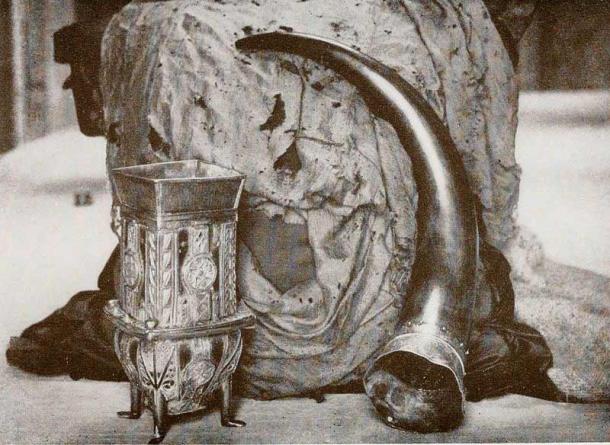
The Fairy Flag is one of the MacLeod Clan relics in Scotland, said to have been gifted to the MacLeod chiefs by fairy folk. ( Public domain )
1. The Fairy Flag: Strange Relic of the MacLeod Clan in Scotland
A relic is not necessarily a religious item. Some of them can be important heirlooms and artifacts with a lengthy heritage and history. One such item is the so-called Fairy Flag, a venerated and very old heirloom of the Chiefs of the Scottish Clan MacLeod . Known in Scottish as Am Bratach Sìth, it is kept in the clan’s seat at Dunvegan Castle and is considered an indivisible part of their heritage.
The Fairy Flag is made from silk that originated in the far east, denoting its luxury status on the remote Isle of Skye. Being very old, it is now quite torn and tattered, and covered with tiny red “elf spots.” Shrouded in mystery, this strange relic has attained legendary status and is said to have magical properties and plenty of healing powers . Its origins are somewhat enigmatic, and the legends state that the MacLeod chiefs were presented with the flag by fairy folk . However, scholars suggested that its origins might lie not with the fairies, but in the Crusades, or the Viking invasions, for whom it could have been a raven banner. Nevertheless, it remains as one of the most precious and strangest in Scotland.
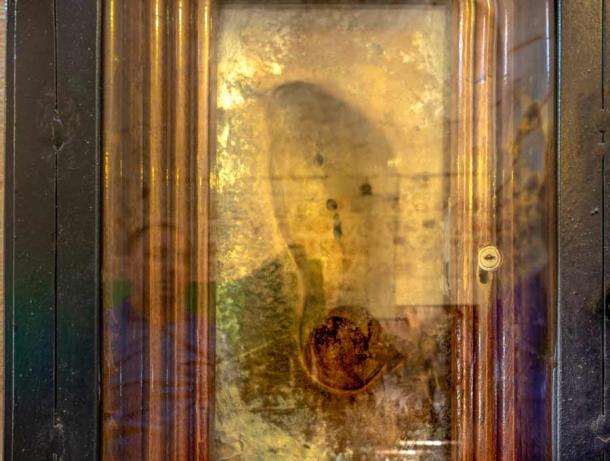
The footprints of the Prophet Mohammad is a selection of artifacts that can be visited across the Islamic world. ( epic_images / Adobe Stock)
2. The Footprints of Muhammad: Petrified Relics of the Prophet
The founder of Islam, the Prophet Muhammad is the most venerated figure of this widespread religion. Accordingly, just like in Christianity, religious relics associated with him are aplenty. But one stands out as quite peculiar: the petrified footprint of Muhammad. Some Muslims believe that wherever the prophet stepped, his left foot made an impression that remained fixed in place.
According to numerous written and oral sources, this prophet left numerous such footprints across the Arabic world. One such alleged footprint is located in the Topkapi Palace in Istanbul, where it is venerated by thousands of believers every year. Some other notable examples of his preserved footprints are located in the mausoleum of Qaitbey in Cairo, or in the Mosque of the Footprint in Qadam, just south of Damascus and directly on the pilgrimage route to Mecca.
Numerous legends are associated with these peculiar relics. One legend says that a royal eunuch of the Nizam (Muslim Indian sovereign) once discovered an imprint after being guided to it by a dream vision of the prophet himself. Whatever one might believe, a petrified footprint is certainly a strange phenomenon, and also one that is quite difficult to skillfully replicate or fake.
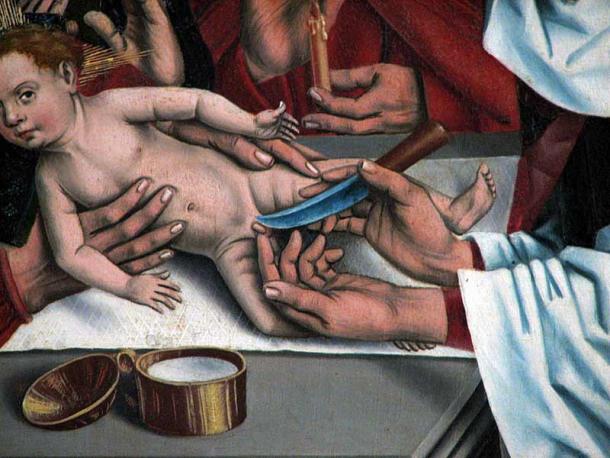
Detail from The Circumcision of Jesus by Friedrich Herlin, an event described in the Gospel of Luke. ( Public domain )
3. The Holy Prepuce of Jesus Christ
Possibly one of the strangest relics in the world, the Holy Prepuce – also known as the Holy Foreskin – is just another in a long line of relics associated with Jesus Christ . This relic allegedly originates from the circumcision of Christ, and became an important religious item in the early periods of Christianity. Numerous healing powers have been attributed to this foreskin, and it was soon claimed as a prized item by several churches in Europe.
Alongside the umbilical cord of Christ, the foreskin had a long and turbulent journey in medieval Europe. In 800 AD, it was given as a present to Pope Leo III by King Charlemagne, who most likely received the relic as a present from the Byzantine Empress Irene. The Pope housed the relic in a lavish jeweled gold cross, which was kept under the altar of the Chapel of Saint Lawrence in Rome.
Alas, with the Sack of Rome in 1527, the jeweled cross with Jesus’ foreskin was looted, and later retrieved in a village north of Rome, Calcata, where it was reportedly kept until 1983, when it was yet again stolen. However, its authenticity at that time was dubious at best, and the actual existence of the Holy Foreskin remains a big enigma. Nevertheless, as far as strange relics go, the veneration of a foreskin is definitely a strange practice.
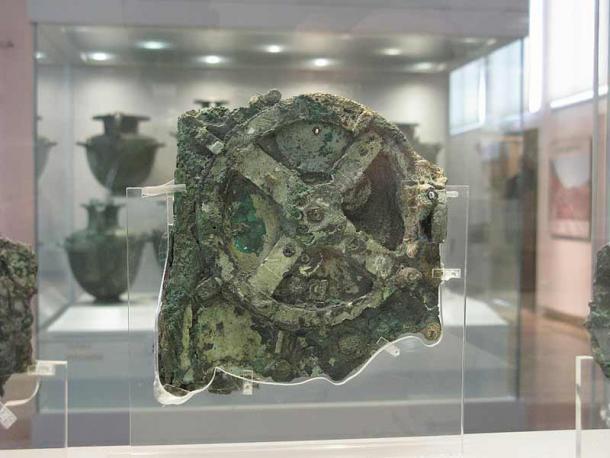
The discovery of the Antikythera Mechanism in a shipwreck off the coast of the Greek island of Antikythera proves the existence of advanced technology as far back as 100 BC. (Tilemahos Efthimiadis / CC BY 2.0 )
5. The Antikythera Mechanism: The Ancient Analogue Computer
Just like religious relics carry a lot of importance for believers, so do the relics of ancient civilizations bear importance for history enthusiasts all over the world. The Antikythera Mechanism remains one of the strangest and most enigmatic discoveries connected with the ancient Greeks, puzzling the scientists to this very day. It was discovered in 1901 off the coast of the Greek island called Antikythera, within a shipwreck at a depth of 45 meters.
The complex gears and mechanism pieces that comprise it were soon recognized, and since then this item has been recognized as one of the world’s first analogue computers. What makes it so strange is the time in which it was built. Being made in roughly 100 BC, it is surprisingly advanced and seems almost futuristic in many ways.
This device is a complex clockwork mechanism that contains more than 30 delicate bronze gears. Scientists proposed that it was used as an orrery, used by the Ancient Greeks to predict astronomical positions and eclipses. Such knowledge could be used for calendar and astrological purposes and provide them with this information decades in advance. As such it is certainly one of the most enigmatic relics of the ancient world.

Golden Palace Events purchased the bizarre religious relic, a grilled cheese sandwich with a depiction of the face of the Virgin Mary, back in 2004 for a stunning $28,000! ( Golden Palace Events )
6. The Virgin Mary Grilled Cheese Sandwich
Yup, you read that right. When it comes to religious relics, the options become limitless. Not all religious relics were discovered in ancient history. The old toast and sandwich manifestation of holy figures is the true relic of modern times, as strange as it may seem. A woman from Fort Lauderdale in Florida, USA, named Diana Duyser, sold her 10-year-old grilled cheese sandwich in 2004 – with one bite taken out of it – for $28,000 on an online auction! But it was no ordinary grilled cheese sandwich: it allegedly bore the image of the face of the Virgin Mary . Mrs. Duyser kept the sandwich sealed for 10 years before deciding to try and sell it – she never assumed it would fetch such a stellar price.
For the faithful, it could be called a miracle. However, those with a bit more reason will realize that it is simply a curious coincidence: the dark crust formed a pattern that surprisingly accurately depicts a female face. This strange modern-day relic was bought by an online casino, the Golden Palace, whose representatives say that they quickly understood the novelty of such a “recognizable part of modern pop culture.” They did not hesitate to pay $28,000 (£20,113) to own it. This makes it the world’s most expensive grilled cheese sandwich!
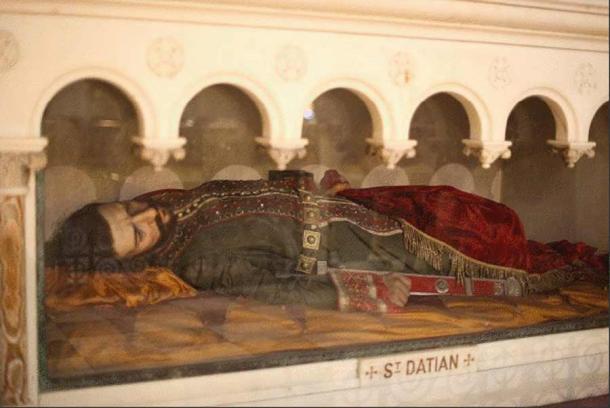
Wax effigy of St. Datian at the Church of the Most Holy Redeemer in New York. ( Village Preservation Blog )
7. The Remains of St. Datian in New York
The tradition of Catacomb Saints spread like wildfire through the Christian world, when holy relics and preserved skeletons of “saints” began emerging throughout the world. One such holy relic is considerably stranger than the others, and it found its way all the way to New York. This relic is the body of Saint Datian.
This odd relic is housed in a glass sarcophagus in the Church of the Most Holy Redeemer in East Village, New York City. Not much is known about Saint Datian. In fact, this saint is virtually unknown in preserved written sources. It is possible that Datian was a cruel roman leader who persecuted Christians zealously, but later repented, became a monk, and was later martyred.
The remains (bones) of this saint arrived at the church in 1892 and were housed in a lifelike wax effigy. The relics were donated to the church by a wealthy Italian lady, but the earlier origins of the bones remain a mystery. But some people quickly placed the authenticity of these remains into question. As early as 1897 it was suggested that the encased remains are actually those of a police officer shot and killed while defending the church from a burglary. This belief remained widespread until the late 1940’s. The truth about this strange relic remains unknown.
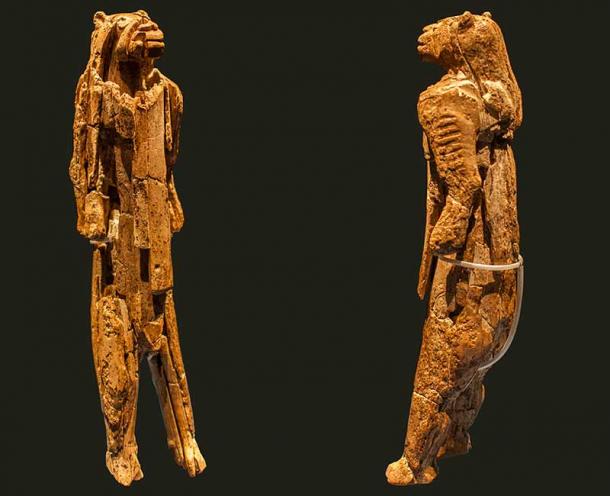
The Lion-Man of the Hohlenstein-Stadel was discovered in a cave in 1939 in Germany and is considered the oldest zoomorphic figurine in the world. (Izquierda: Dagmar Hollmann / CC BY-SA 3.0 . Derecha: Thilo Parg / CC BY-SA 3.0 )
8. The Lion-Man of the Hohlenstein-Stadel: Prehistoric Ivory Relic
Religion – whether monotheistic or polytheistic – has deep and ancient origins. What beliefs did our earliest ancestors have? Have some of their ancient relics survived until today? The Lion-man, known also as Löwenmensch, is an elaborate prehistoric mammoth ivory figurine that quite possibly depicts an ancient mythical being worshipped by the prehistoric man. In 1939 it was discovered in a cave in Germany and is considered the oldest zoomorphic figurine in the world. Dated to the Upper Paleolithic, it is roughly 40,000 years old and was made from mammoth ivory .
Researchers came to a conclusion that the lion-headed figure was an important part of the mythology of the Paleolithic humans inhabiting this region. It also might be one of the earliest connections with shamanism. It deepens the mystery of numerous Paleolithic depictions of “beast-men,” like the bird-headed man from the Lascaux Cave , the lion-woman from Chauvet Cave , or the stag-headed “Sorcerer” from the Trois Frères cave. Prehistory was undoubtedly strange, seen now from our modern point of view, and ancient relics are all that remains of their belief systems.
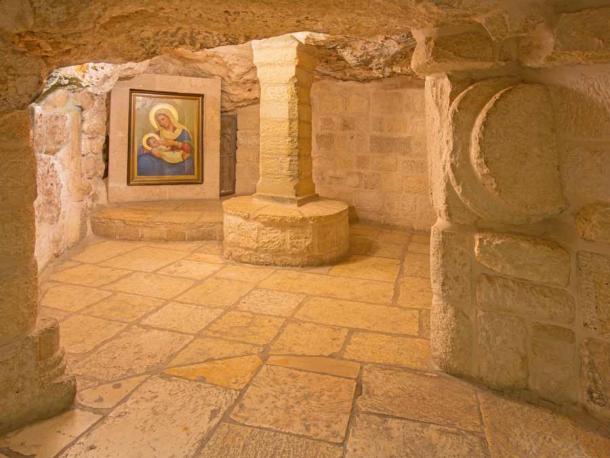
The Chapel of the Milk Grotto of Our Lady in Bethlehem takes its name from the belief that the Virgin Mary found refuge in a cave with the infant Jesus and a drop of her milk fell on the cave floor, turning it white. ( Renáta Sedmáková / Adobe Stock)
9. Breast Milk of the Virgin Mary in Bethlehem
Another in a long line of strange Christian relics is the so-called breast milk of the Virgin Mary . “The Nursing Madonna,” or Maddona Lactans , has been often depicted in Christian religious art, nurturing the baby Jesus at her breast. But did you know that her breast milk is venerated as a relic? It is situated in the Chapel of the Milk Grotto of Our Lady in Bethlehem, some 10km south of Jerusalem. Ever since the Byzantine Era, this site has been frequented as one of the major Christian pilgrimage sites. It is believed that Virgin Mary found refuge in this grotto with infant Jesus, and while she breastfed him a drop of her milk fell on the cave floor and turned it white.
Pilgrims visit this site, especially those couples seeking to conceive a child as the faithful believe that this shrine helps those suffering with infertility. The Catholic officials sought to capitalize on this belief, selling limestone powder made from the stone of the grotto, which ought to be diluted in water and drank. It supposedly helps cure infertility. You thought that veneration of a foreskin is strange? How about drinking powdered cave floor? This strange relic is as strange as can be.
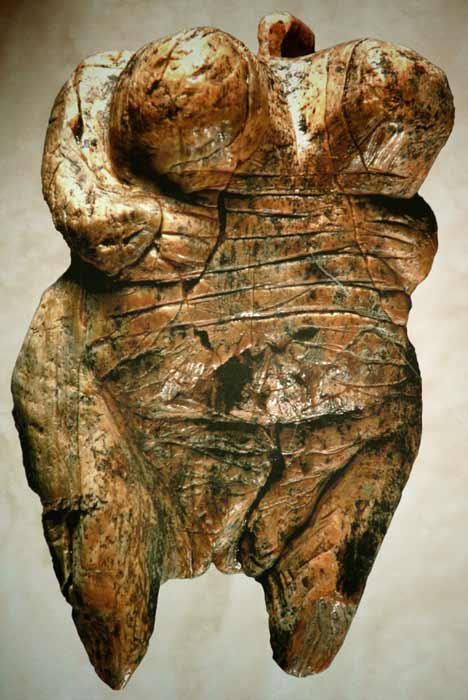
The Venus of Hohle Fels (Ramessos / CC BY-SA 3.0 )
10. The Venus of Hohle Fels: 40,000-Year-Old Ivory Sculpture
Venus figurines are the most iconic relics of the world’s earliest history. These fertility symbols were one of the major cultic items for early humans, and pose a great insight into their cryptic and mysterious beliefs. The Venus Of Hohle Fels is one of the strangest of all ancient relics, and can be interpreted in many ways. Unearthed in the Hohle Fels cave in Germany, this ivory sculpture is dated to the very beginning of the Upper Paleolithic period, some 40,000 years ago. It is the oldest, undisputed depiction of a human being and gives us a crucial glimpse into the earliest origins of Cro-Magnons in Europe.
This relic might look strange to us, but for the early man it might have been a revered mythical concept. It depicts a buxom – perhaps even obese – woman with enormous breasts, a large (pregnant) belly, and a prominent vulva. These are clear connections with fertility. It can be easily understood that life was quite hard in the Upper Paleolithic and infant death rates could have been quite high. People were also probably malnourished and lean, so a depiction of a buxom, hale, and fat woman could have been an ideal of health, fertility, prosperity, and good life. Either way, we will never know the true meaning of the Venus figurines, and this one remains a truly strange ancient relic.
Top image: The relics humans have chosen to worship over the course of human history can often help us understand the extent of belief systems and the anatomies of faith. Source: Top: Village Preservation Blog Bottom: epic_images / Adobe Stock; Public domain ; Golden Palace Events
By Aleksa Vučković
Related posts:
Views: 0
 RSS Feed
RSS Feed

















 March 3rd, 2021
March 3rd, 2021  Awake Goy
Awake Goy  Posted in
Posted in  Tags:
Tags: 
















